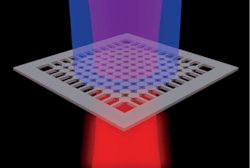Unconventional laser based on 'bound states in the continuum' could have wide application
Researchers at the University of California San Diego (UCSD) have demonstrated the first laser that is based on "bound states in the continuum" (BIC), an unconventional wave-physics phenomenon.1 The potential results is a new kind of compact and energy-efficient surface laser tunable for different communications and computing applications. The new BIC lasers could also be developed as high-power lasers for industrial and defense applications.
Bound states in the continuum (BICs) are phenomena that have been predicted to exist since 1929. BICs are waves that remain perfectly confined, or bound, in an open system. Conventional waves in an open system escape, but BICs defy this norm; they stay localized and do not escape despite having open pathways to do so.
The BIC laser in this work is constructed from a thin semiconductor membrane of indium gallium arsenide phosphide (InGaAsP). The membrane is formed as an array of nanosized cylinders suspended in air. The cylinders are interconnected by a network of supporting bridges, which provide mechanical stability to the device. The membrane is optically pumped and emits at a longer wavelength in the telecommunications spectral region.
Surface lasing occurred for geometries with nanoresonator arrays as small as 8 x 8.
"The popular VCSEL [vertical-cavity surface-emeitting laser] may one day be replaced by what we’re calling the 'BICSEL'—bound state in the continuum surface-emitting laser, which could lead to smaller devices that consume less power," says Boubacar Kanté, electrical engineering professor at the UC San Diego Jacobs School of Engineering who led the research. The team has filed a patent for the new type of light source.
The array can also be scaled up in size to create high power lasers for industrial and defense applications, he notes. The team's next step is to make BIC lasers that are electrically pumped, rather than optically pumped.
Source: UC San Diego
REFERENCE:
1. Ashok Kodigala et al., Nature 541 (2017); doi: 10.1038/nature20799
About the Author
John Wallace
Senior Technical Editor (1998-2022)
John Wallace was with Laser Focus World for nearly 25 years, retiring in late June 2022. He obtained a bachelor's degree in mechanical engineering and physics at Rutgers University and a master's in optical engineering at the University of Rochester. Before becoming an editor, John worked as an engineer at RCA, Exxon, Eastman Kodak, and GCA Corporation.

